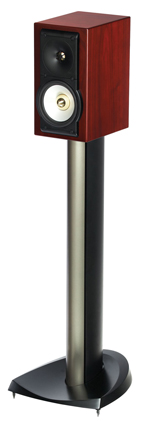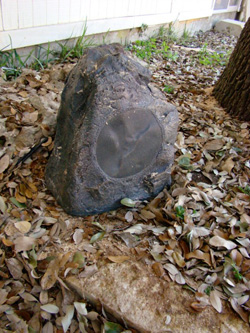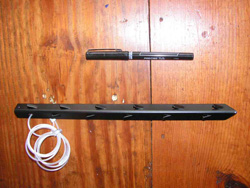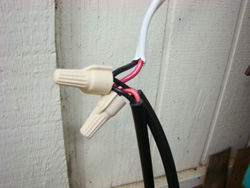Introduction
I admit, I’ve always been a little cynical about outdoor speakers. What better chance for a manufacturer to knick you a little extra for the ability to leave them out in the rain. Just walk into any big box store and you will see models of outdoor speakers from ho-hum manufacturers that command at least twice what their comparable indoor speakers cost. Hook them up and you will quickly find that serious corners were cut in regard to sound quality in order to “seal” them from the elements. That’s the experience I took into this review, as I’d never experienced anything else.
Specifications
- Design: Two-way, Sealed Enclosure
- Drivers: Two 1″ Metal Dome Tweeters, Two 7.5″ Woofers
- MFR: 63 Hz – 20 kHz
- Sensitivity: 90 dB
- Crossover Frequency: 2.5 kHz
- Nominal Impedance: 8 Ohms
- Dimensions: 15.2″ H x 13.4″ W x 13″ D
- Weight: 17 Pounds/each
- Finishes Northeastern Dark Granite, Western Sandstone, Fieldstone
- MSRP: $858/pair USA
- Paradigm
Design
I unboxed these on a rainy day and was not able to install outside so I set them up in my living room and did an A-B comparison with my Paradigm Studio 20v.3, definitely cut from the same cloth, similar treble but weaker midrange and low end than 20’s, understandably from smaller enclosure and drivers. The fact is that they use the same high-frequency driver and similar low frequency driver as the new and improved Monitor series speakers, which have been heralded as the new budget audiophile standard. My system is PS3, iPod shuffle and nano, Denon AV2309, and the Onkyo RC-160 I was currently reviewing. Connections were made with Monoprice HDMI 1.3a and speaker cabling was my standard Blue Jeans Cable BJC twelve white for all speaker connections. Just for the record, there was very little discernable difference between the two receivers when playing MP3s or CDs outside.
These speakers come with security spikes that are supposed to be driven twelve inches into the ground and then attached to the speaker to prohibit someone from making off with them. I had two problems with this. First, the cord that attaches to the security spike is plastic and easily cut. Second, the spike, while hard to get out of the ground, certainly wouldn’t deter anyone serious about stealing a pair of $800 speakers, I’d recommend a longer spike that attaches directly to the bottom of the speaker which would prohibit them from getting too much leverage without damaging the speaker itself (who wants to steal a busted speaker?). Another good alternative would be a small steel cable similar to the ones included with a Kensington lock.
Paradigm’s description of the speaker: a “3-driver, 2 x 2-way coaxially mounted high-frequency drivers, Single speaker system” is curious. How are they getting stereo sound from a “single speaker system?” The first thing I noted about their sound is that the dual tweeters in each speaker (see picture below) seem to be wired out of phase from each other (meaning the positive and negative terminals are reversed) but in phase with one of the tweeters from the other speaker. This is what allows the speaker to give you a surround feel with only two speakers. While I’ve found out of phase speakers to not be ideal in the past, it appears that Paradigm engineers really got it right with these and they pull of the desired effect of giving very dispersed sound with very good detail by essentially placing ½ of each channel of stereo inside each of the speakers. I also find it interesting that the setup of the driver array mimics some of the new surround sound speakers that are used for dipolar use (or a rear center channel in some instances), with a larger midrange cone mounted behind the dual tweeter array. I wouldn’t think this a likely configuration for a stereo pair, but it seems to work well for the Paradigm. Maybe they’ll release this as a surround option for future Studio series speakers as well.
The review period was approximately 3 months through some of the harshest conditions that Texas has seen; starting with 100-degree days, then a foot of rain, then sleet/freezing rain/40 mph wind and finishing off with 2 weeks of weather where the low was in the teens and single digits and highs near 60. Through all of this, the Paradigms cranked right up when asked to and their sound never changed. Though this is what is expected of outdoor speakers, it wouldn’t surprise me to learn that speakers from other manufacturers might not fare as well.
Setup
I also experimented with placement. Though outdoor speakers tend to be a little less tricky than indoor speakers, the same rules of physics apply. My back yard is fairly large, approximately 120’X 50′, and though I did experiment with setting the speakers up to cover the entire area, I decided that it made more sense to focus their sound over a smaller listening area due to drawbacks with sound deterioration over larger distances. I have a primary seating area out back that measures ~15X15, and I used this as the area that I wanted maximum sound quality. I placed them directly up against my house and got a little too much boundary reinforcement, though when I placed them out in the yard they tended to sound a little thin by comparison. I opted for about a foot away from exterior walls for a balance, you should experiment with placement for optimal sound in your setup. (Better yet, ask the neighbors where they’d like you to put them…what’s that? Right up against the fence? You got it!)
In Use
After setting these up outside and getting the balance adjusted where they were the same volume at my primary listening area on my patio, I was truly blown away by their sound. The Paradigms were designed to be able to breathe. The speakers are a dual tweeter (see pic); single midrange design meaning you can almost get surround sound from two correctly placed speakers. On Norah Jones Come Away With Me the “Painter Song” sounded extremely airy (but not windy), articulate, balanced with just enough low end not to sound muddy (oh, I just can’t stop with the outdoor adjectives!) but while giving me the impression that I wasn’t missing anything either. These speakers have a great ability to resolve detail quietly, and lend themselves well to playing in the background without disrupting the conversation.
On Jack Johnson’s Sleep Though the Static, I noticed on “All At Once” more levels of amplifier feedback than I ever have several distinctly different pitches of hum and something that was present in the recording all along. I also listened to my classical music radio station KMFA and, while the sound was good, I don’t think the pianissimo sections from Stravinsky’s “The Firebird” get much justice from an outdoor speaker with all of the ambient noise heard in the city. Similarly, these speakers do fairly well with rock but they are best suited for background, low -level listening and outdoor conversation.
The speakers did well with rock, though they tended to shine on material like Stevie Ray Vaughn and Double Trouble’s The Sky is Crying. On the more guitar-centric pieces like “Little Wing” and “Life by the Drop,” I could hear the ambience of the recording room and Stevie lightly rapping his guitar for rhythm. They were no slouch in harder material like “May I Have a Talk With You” where reproduction of vocals and guitar were first rate, if not quite as defined as you might hear in a typical 2 channel setup due to the arrangement of stereo drivers so close to one another in the enclosure.
Finally, I played the same variety of music listed above with my receiver set to output the same sound to all connected speakers. After level matching the indoor and outdoor speakers, I listened outside on the patio for a few minutes and then stepped just inside my patio door to the living room where my Paradigm Studio 20’s were playing the exact same music. Through several repetitions of this with different material I found that the sound of the SM-80’s was definitely more open and airy, though when within the optimal distance from them, gave up very little in the lower end (bass). The indoor Studio speakers sounded a little stuffy by comparison, though with their huge soundstage and better bass performance they were able to keep up. The SM-80’s seemed to have a huge soundstage though they gave up a little in the imaging department, which I think is a wise tradeoff in an outdoor speaker.
In sum, I actually preferred the sound of the outdoor speakers in most music and I think that they would make a phenomenal speaker used in conjunction with a backyard projector for bar-b-que/movie nights.
Drawbacks
The main drawback I can see is price, but I feel one would get a lot of speaker for the money with these. Also, as the dipole speakers come with 4 speaker wires per speaker, I was never fully sure that I had them twisted together well so I ended up using screw cap connectors which weren’t the best looking solution. Maybe the company could start twisting them together at the factory. I tried only connecting one of the speaker wires and it only engages one of the tweeters and the sound was flat as a result, definitely not their intention so I’m not sure of the reason these aren’t pre-connected.
Also, these speakers have a range in which full-bodied sound can be heard, probably around 15′ away. As you get outside that distance the sound quality deteriorates significantly and mainly treble can heard outside this perimeter. I guess the solution to this would be to buy enough speakers for denser coverage so that one is never farther than 15′ away, but at their price this becomes more of an issue.
Another solution which has not been implemented frequently is the use of an external all-weather subwoofer enclosure. Sure, it would be hard to disguise unless you could build a water feature around the “Boulder Sub”, but it would probably mitigate the problem of low frequency loss due to placement of the speaker (though a sealed enclose might be necessary in the outdoors).
Conclusions
Paradigm pulled out the stops on these, and they sound better for an outside speaker than many more expensive indoor speakers. With the right listening material these speakers will really blow your hair back (anything acoustic or any decently recorded vocalist) without spending too much on the amplification. If you’ve got the cash, I doubt there is a better outdoor patio speaker out there.







